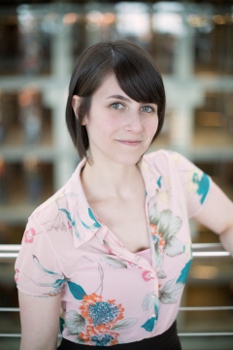
Poet’s Math
Contributor’s Marginalia: Hannah Stephenson on “Lost Earring” by Alexandra van de Kamp
In the mathematics of language, “and” is a plus sign. This joins that. Sometimes one entity is submerged in the other, and sometimes they congregate alongside one another in clusters, like ducks and geese.
“And” is the word and concept in the gas tank of Alexandra Van de Kamp’s “Lost Earring.” The poem opens by talking about poetry, which doesn’t always work for me. But in this case, I love the effect— Van de Kamp wants to speak explicitly about making words, art, and meaning. The poem begins with this statement: “A poet once told me that he wrote a poem simply/ to write a poem—no other premise was required./I found that freeing.” I agree with the speaker here—doesn’t that sound freeing? When we free ourselves from the responsibility of a beautiful or weighty product, we can relax into the act of making.
The speaker goes on to describe another poet’s project, in which “he had decided to study one word for a whole year.” In comparison to the previous, breezy style of working, this sounds much more goal-oriented and focused. The studied word is revealed to be “and,” and while the speaker initially finds this choice dull, she goes on to become taken with the idea. She marvels at “how much an and/ can connect: a carrot to a blushing radish; a melodramatic/ sadness to a scissor-sharp glee.” The language grows playful, hyphenated—I envision the gleeful rubbing-together-of-hands and muah-ha-haing of a faux-villain (a la Sesame Street’s The Count or Dr. Evil).
And here’s where the poem’s engine revs. A meditation on “and” gives way to the speaker calling the word “one of the primary colors in the language,/ like one of Rothko’s blues receding further and further/ into his canvas—an unstoppable hallway of blue,/ an unraveling cobalt bandage.” Note, too, the em dash (the poem’s second). This is a poem of hyphens and dashes, of interruptions and additions and slipping from one idea to another.
In the final lines of the poem, that’s exactly what we get—a succession of small, strange, charged images that pull the reader into the mind of the poet. This is one of my favorite qualities of art. Suddenly, we inhabit the mind and body and memory of another human. The speaker here recalls “the lost earring shaped like a black tear/ my husband gave me, and the wedding I wish/ I had attended in northern Spain…with that region’s most famous cheese shaped/ like a woman’s breast, and the trees so dense/ they emitted a chartreuse fog in the evenings.”
Wait a minute—where are we here? We began with a lost earring, and then flitted to Spain, and then there’s the breast-shaped cheese, and green foggy trees…we’ve been sucked down the Rothko-vortex, down the hallway of the poet’s consciousness. I have no doubts that the earring is real, and the exotic cheese, and the mystery wafting from the trees. This might be a poem that began with the simple plan to write a poem, but look what’s happened. The “and” is infectious and wants to echo. Van de Kamp’s lovely, dreamy poem tells me that the maddening, wonderful thing about “and” is that it’s a plus sign without an equals sign.
